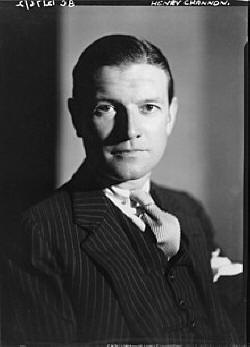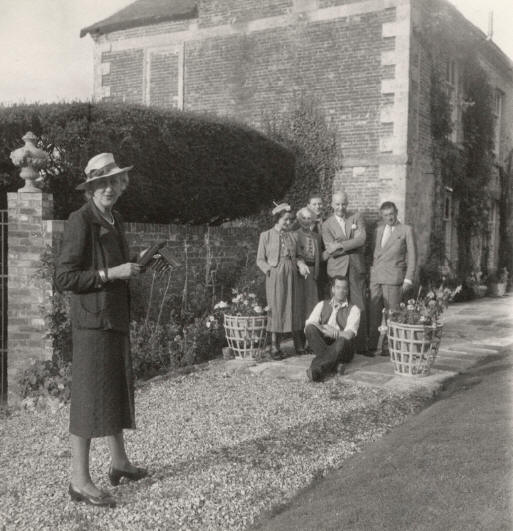Queer Places:
University of Oxford, Oxford, Oxfordshire OX1 3PA
5 Belgrave Square, Belgravia, London SW1X 8PH, UK
Kelvedon Hall, Kelvedon Hall Ln, Kelvedon Hatch, Brentwood CM14 5TG, UK
 Sir
Henry Channon (7 March 1897 – 7 October 1958), often known as Chips Channon,
was an American-born British Conservative politician, author and diarist.
Channon moved to England in 1920 and became strongly anti-American, feeling
that American cultural and economic views threatened traditional European and
British civilisation. He wrote extensively about these views. Channon quickly
became enamoured of London society and became a social and political climber.
Sir
Henry Channon (7 March 1897 – 7 October 1958), often known as Chips Channon,
was an American-born British Conservative politician, author and diarist.
Channon moved to England in 1920 and became strongly anti-American, feeling
that American cultural and economic views threatened traditional European and
British civilisation. He wrote extensively about these views. Channon quickly
became enamoured of London society and became a social and political climber.
Channon was first elected as a Member of Parliament (MP) in 1935. In his
political career he failed to achieve ministerial office and was unsuccessful
in his pursuit of a peerage, but he is remembered as one of the most famous
political and social diarists of the 20th century. His diaries have so far
been published only in an expurgated edition.
In 1933, Channon married the brewing heiress Lady Honor Guinness
(1909–1976), eldest daughter of Rupert Guinness, 2nd Earl of Iveagh.[10]
In 1935 their only child was born, a son, whom they named Paul.[2]
Lady Honor Guinness' sister, Brigid, married
Frederick of Prussia (Both these attractive, fabulously wealthy women each married a gay man).
On 31 January 1936, the Channons moved into a grand London house at 5 Belgrave
Square, near the London house of the Duke of Kent,[11]
and two years later also acquired a country estate at Kelvedon Hatch, near
Brentwood in Essex.[1]
Channon quickly established himself as a society host, in his famous blue and
silver dining room designed by Stéphane Boudin and modelled on the
Amalienburg.[12]
Perhaps the apogee of his career in that role came on Thursday, 19 November
1936, with a guest list headed by Edward VIII, Prince Paul of Yugoslavia, then
Regent and his wife Princess Olga of Greece and Denmark, the Duke of Kent and
his wife Princess Marina of Greece and Denmark and Mrs Simpson, of whom
Channon was a friend and admirer. Twenty-two days later, on 11 December,
Edward abdicated.

Lady (Gladys Mary) Juliet Duff (née Lowther); Lynn Fontanne; Alfred Lunt; Simon Fleet; Chips Channon
by Cecil Beaton
bromide print, 1948
5 3/8 in. x 5 3/8 in. (138 mm x 138 mm)
Accepted in lieu of tax by H.M. Government and allocated to the Gallery, 1991
Photographs Collection
NPG x40084
In July 1939, Channon met the landscape designer
Peter Daniel Coats
(1910–1990), with whom he began an affair that led to Channon's separation
from his wife the following year and the dissolution of the marriage in 1945.[1]
Despite Channon's conduct, it was he who sued for divorce. His wife, who had
left him in favour of a Czech airman,[6]
did not contest the suit and he was, therefore, theoretically the innocent
party.[15]
Among others with whom he is known to have had affairs was the playwright
Terence
Rattigan, and Channon was on intimate terms with Prince Paul of Yugoslavia
and the Duke of Kent, though whether those relationships were platonic or
otherwise is not yet known.[1]
Once it became clear that he would not achieve ministerial office, Channon
sought elevation to the peerage, but in this, too, he was unsuccessful. The
highest honour he achieved was a knighthood in 1957, the year before his
death.[1]
My published books:


BACK TO HOME PAGE

- https://en.wikipedia.org/wiki/Henry_Channon
 Sir
Henry Channon (7 March 1897 – 7 October 1958), often known as Chips Channon,
was an American-born British Conservative politician, author and diarist.
Channon moved to England in 1920 and became strongly anti-American, feeling
that American cultural and economic views threatened traditional European and
British civilisation. He wrote extensively about these views. Channon quickly
became enamoured of London society and became a social and political climber.
Sir
Henry Channon (7 March 1897 – 7 October 1958), often known as Chips Channon,
was an American-born British Conservative politician, author and diarist.
Channon moved to England in 1920 and became strongly anti-American, feeling
that American cultural and economic views threatened traditional European and
British civilisation. He wrote extensively about these views. Channon quickly
became enamoured of London society and became a social and political climber.


